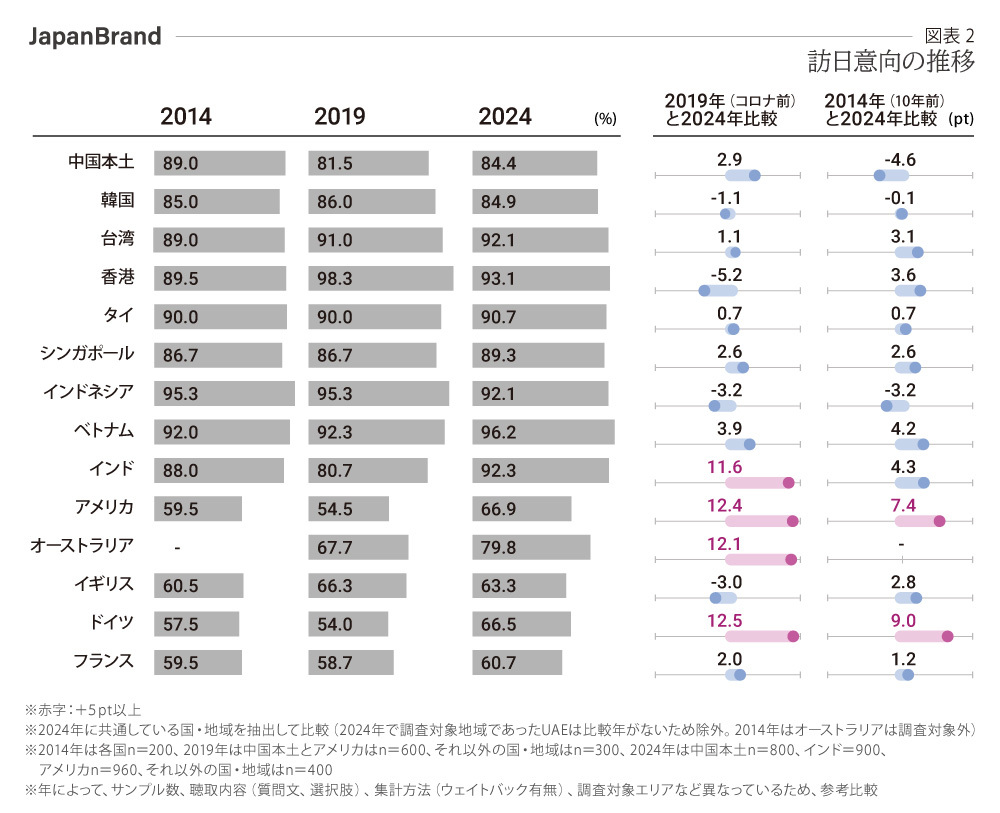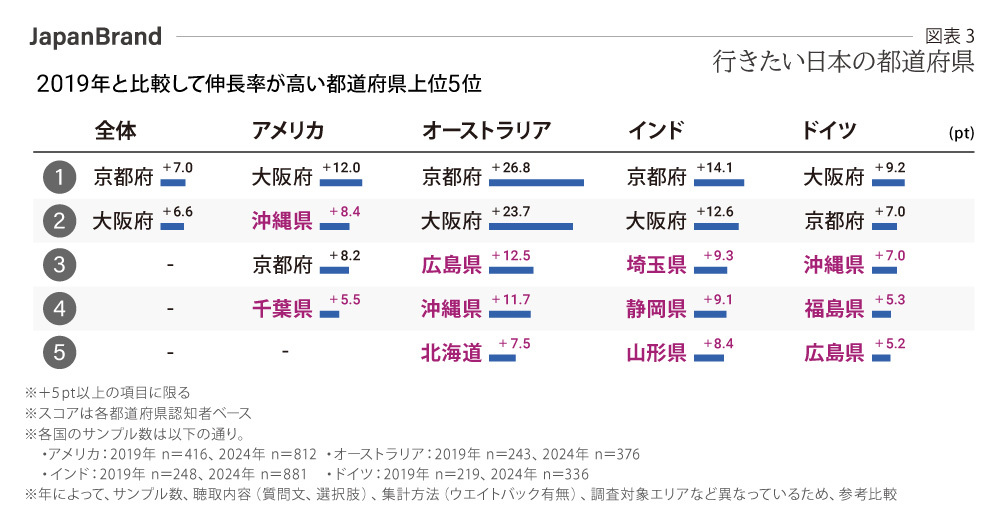In Part 1, we analyzed the current state of the "Japan Brand" from eight perspectives based on the latest 2024 survey. In this second installment, we will focus specifically on "inbound tourism." By reviewing past surveys, we aim to understand the evolution that led to the current state and gain deeper insight into how the world perceives Japan.
Maintaining 80% "Japan Lovers." Growing fanbase in the US and Australia
The Japan Brand Survey continuously gauges positive sentiment toward Japan. The 2024 results show that around 80% of respondents overall answered "like," maintaining the same high level of favorability as 10 years ago. Comparing by country/region, Asia remains at the top, though rankings have shifted slightly, with Southeast Asian countries now occupying the top three spots.
Meanwhile, outside Asia, the US has risen in ranking, showing a significant improvement of +7.2 points compared to five years ago (+8.0 points compared to ten years ago). Australia, while unchanged in ranking since 2019, saw its score rise by +5.3 points. Both countries show increased interest in Japan and action, such as rising visitor numbers, alongside this growing favorability.
Favorable sentiment and skyrocketing visit intentions! USA, Australia, India
Germany, where visit intentions skyrocket regardless of sentiment!
Looking at the trend in visit intentions since we began surveying 10 years ago, while some countries saw a dip in 2019, many have maintained or improved their scores overall. Compared to 2019, just before COVID-19, scores have skyrocketed by over 10 points in the US and Australia, where favorability has increased, and in India, which has returned to the top 5 ranking.
As mentioned in past articles, we believe a positive attitude toward Japan likely fuels the desire to visit. On the other hand, Germany stands out as a country where the desire to visit Japan has significantly increased compared to 2019, even though its overall favorability hasn't risen.
Germany ranks second only to mainland China in outbound travelers and is considered one of the world's leading travel nations. It can be inferred that Germans, accustomed to overseas travel, recognize Japan's appeal as a destination regardless of their existing favorability. This suggests a potential pathway: rather than visiting Japan solely due to existing affection or interest in the Japan brand, the trip itself could foster new affection and further expand interest in the Japan brand.
The desire to visit regional areas, from Hokkaido to Okinawa, has skyrocketed!
Visiting Kyoto, I used to notice many tourists from Asia, but now I'm surprised by the large number of Western tourists. This trend is also evident when comparing with the past. Compared to pre-COVID (2019), when many countries saw significant changes in their intention to visit Japan, the scores for "Kyoto" and "Osaka" as desired prefectures to visit increased overall.
This trend was also seen in the US, Australia, India, and Germany, where the desire to visit Japan increased significantly, with some countries seeing scores rise by 10 points or more. Beyond Kyoto and Osaka, distinct preferences emerged by country.
The United States and Australia showed interest in "Okinawa" or "Hokkaido." India expressed interest in "Saitama," "Shizuoka," and "Yamagata," areas accessible by train or bullet train from Tokyo. Germany, with its experienced travelers, showed heightened interest in historical locations like "Fukushima" and "Hiroshima" (with "Nagasaki" as a close second, though not listed).
Morioka City was selected for The New York Times' "52 Places to Go in 2023," while Yamaguchi City was chosen for "52 Places to Go in 2024." This growing attention to Japan's regions is likely a key factor behind the significant surge in visit intentions.
Is the broadening range of things people want to do in Japan the key to the explosive growth in visit intentions and regional interest?
So, what lies behind this broadening of desired destinations in Japan? While the options differ, comparing the top 10 items for "Things to Do in Japan" from the 2015 survey (about 10 years ago) and the 2024 survey reveals noticeable changes in content.
"Japanese cuisine" has consistently ranked high among things people want to do in Japan since the 2015 survey. This trend remains unchanged in the US, Australia, and India. The 2024 survey even shows two food-related items in the top rankings, indicating a desire to experience Japanese cuisine from various angles.
India, in particular, shows a notable shift. While interest in Japanese cuisine was relatively low compared to other countries/regions ten years ago, the 2024 survey reveals a significant rise in its ranking, indicating substantially heightened interest in Japanese food itself.
Conversely, in Germany, purely tourism-oriented activities like "visiting Japanese gardens" and "touring shrines and temples" ranked higher than Japanese cuisine, clearly reflecting the preferences of travel-loving Germans.
Furthermore, in Australia, India, and Germany, items like "visiting Japan's World Heritage sites" and "taking the Shinkansen for regional sightseeing" also ranked highly. This reaffirms that the diversification of "things to do in Japan" is a key factor behind the growing interest in visiting regional areas mentioned earlier.
Japanese cuisine, a key inbound motivation, also gains breadth and depth!
Finally, let's examine the expansion of Japanese cuisine, a major motivation for visiting Japan. In the 2015 survey, about 10 years ago, when asked what Japanese dishes they wanted to eat, "sushi," "tempura," and "sashimi" were the top three.
In the 2024 survey, the question was rephrased to "What do you want to eat in Japan?", with "ramen" taking the top spot alone. Additionally, "kaiseki cuisine" was cited as a traditional Japanese dish, and entertainment-focused Japanese foods like "teppanyaki" rose in the rankings. Furthermore, fried foods like "karaage" and "tonkatsu," as well as Western-style dishes like "ebi fry," also ranked highly. This suggests a broadening and deepening of the range of Japanese cuisine people want to experience.
We observed a positive chain reaction emerging: the growing desire to experience culinary delights, ranging from classic staples like "The Japanese Cuisine" to everyday gourmet fare, is further boosting inbound travel intentions.
This time, we examined the trends of the Japan Brand Survey, which has been ongoing for over a decade, specifically from the perspective of "inbound tourism." The survey results clearly show what many people intuitively feel: over the past decade, information about Japan has increased, gaining breadth and depth, moving away from the stereotypical perception of "Japan means Tokyo" and "Japanese food means sushi." This shift is driving inbound tourism.
We anticipate that tourists will increasingly seek diverse experiences and visit all corners of Japan. Building on this foundation, the Japan Brand Survey Project Team will continue exploring how to further increase touchpoints with the Japan brand for a broader audience.
※1: Country and region names in this article are written with Japanese readers in mind, following Japanese social conventions and business practices.
※2: Percentage figures in this survey are rounded to the nearest hundredth (or first decimal place where applicable), so totals may not add up to 100%.
【Contact for Inquiries Regarding This Matter】
Dentsu Inc. Japan Brand Survey Project Team
japanbrand@dentsu.co.jp
【About the Dentsu Inc. Japan Brand Survey】
Dentsu Inc.'s proprietary survey launched in 2011 to understand how the Japan brand was perceived globally following reputational damage to Japanese agricultural/fishery products and inbound travel caused by the Great East Japan Earthquake. In 2022, the survey underwent a major redesign of its methodology and output, evolving into a company-wide cross-functional project.
It regularly gauges the awareness and actual attitudes of overseas residents regarding the Japan Brand as a whole, covering areas such as inbound tourism, food, Japanese products, content, and values. By visualizing the changing sentiments of consumers and the challenges facing the Japan Brand, it contributes to increasingly complex corporate activities and promotes cross-cultural understanding within Japanese society.
【Dentsu Inc. Japan Brand Survey 2024 Overview】
・Target Areas: 15 countries/regions (United States, Australia, United Kingdom, Germany, France, India, United Arab Emirates, Indonesia, Singapore, Thailand, Vietnam, Mainland China, Hong Kong, Taiwan, South Korea)
・Respondent Criteria: Men and women aged 20-59 (middle-income and above)
・Sample Size: 7,460 (Breakdown: USA 960, India 900, Mainland China 800, Other countries/regions 400 each)
・Survey Method: Online survey
・Survey period: January 19 to March 26, 2024
・Research Institution: Video Research Ltd.
*3: Mainland China survey areas limited to Shanghai and Beijing; India survey areas limited to Delhi, Mumbai, and Bengaluru.
※4: Definition of middle-income earners: Conditions set for each country based on national average income levels (e.g., OECD statistics) and social class classification (SEC).
※5: Samples were collected with equal allocation by gender and age group for each country/region, then weighted to match the population composition.









